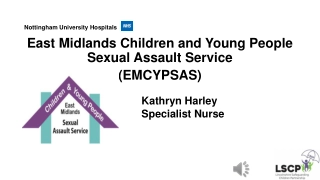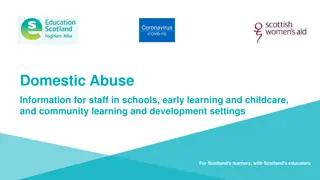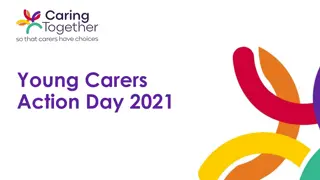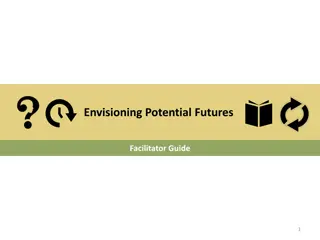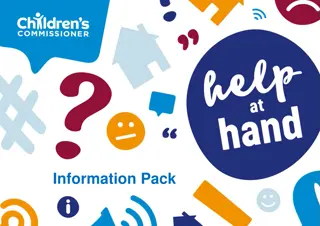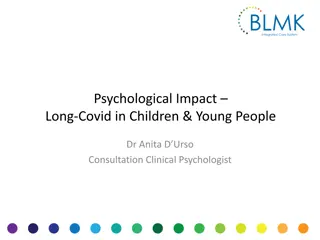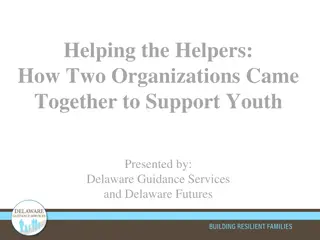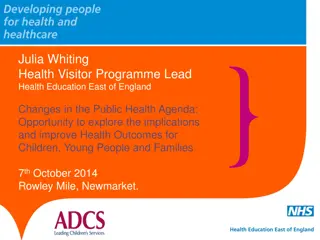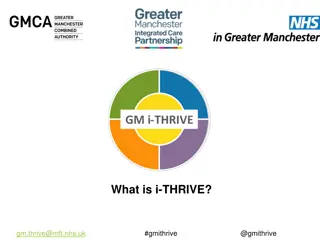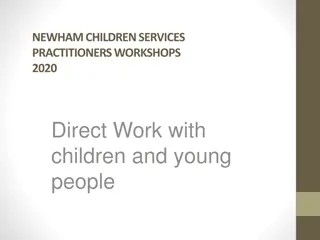Fairer Futures: Delivering Outcomes for Children and Young People
This content discusses the framework and approach of Ofsted's new inspection system, ILACS, focusing on improving social work practices and interactions with local authorities to support children and young people better. It highlights the shift towards a more proactive and collaborative system to prevent inadequacy and promote positive outcomes.
Download Presentation

Please find below an Image/Link to download the presentation.
The content on the website is provided AS IS for your information and personal use only. It may not be sold, licensed, or shared on other websites without obtaining consent from the author.If you encounter any issues during the download, it is possible that the publisher has removed the file from their server.
You are allowed to download the files provided on this website for personal or commercial use, subject to the condition that they are used lawfully. All files are the property of their respective owners.
The content on the website is provided AS IS for your information and personal use only. It may not be sold, licensed, or shared on other websites without obtaining consent from the author.
E N D
Presentation Transcript
Fairer Futures Delivering Outcomes for Children and Young People Chaired by: Cllr Carl Les CCN Spokesman for Education and Children s Services
Fairer Futures Delivering Outcomes for Children and Young People Yvette Stanley National Director of Social Care, Ofsted
Ofsted new inspection framework (ILACS) focus on creating the right environment Yvette Stanley, National Director of Social Care County Councils Network
A system, not a programme of inspections Includes: annual self-evaluation of social work practice an annual conversation with each local authority (LA) focused visits on a potential area of improvement or strength standard or short inspection of each LA, depending on what we know (once in a three-year period) inadequate LAs continue to receive quarterly monitoring and a re- inspection through the single inspection framework (SIF)
ILACS: An inspection system ILACS is a system, with each feature informing how the other works This means more frequent engagement between Ofsted inspectors and LAs (not always as part of an inspection) We want to help catch LAs before they fall we want to help LAs avoid becoming inadequate We don t want to wait until inspection to find this has happened More frequent contact also helps us to make inspection more efficient and less burdensome
Local authority contact with Ofsted Requires improvement to be good local authority Good or outstanding local authority Inadequate local authority Quarterlymonitoring visits Standard inspection (once in a three year period) Short inspection (once in a three year period) SIF or post-monitoring SIF Up to two focused visits in between inspections Up to two focused visits in between inspections Annual conversation Shared self-evaluation Possible JTAI (would replace a focused visit) Possible JTAI (would replace a focused visit) Annual conversation Annual conversation Shared self-evaluation Shared self-evaluation
State of the nation Outcome Outstanding Inadequate Good Requires Improvement
ILACS so far Up and running with ILACS since January 2018 and the consensus seems to be it is going really well. By August we had completed 55 ILACS inspections (4 short, 12 standard and 39 focused visits). By the end of the first year (December) we will have completed 96 (8 short, 22 standard and 66 focused visits)
ILACS so far In addition we will have undertaken monitoring in 24 local authorites of which we will have re-inspected seven. During the first year of ILACS we will have inspected in 120 local authorities, plus had annual engagement meetings with almost all local authorites following the sharing of their self-evaluation of practice with children and families.
ILACS so far When you compare that to the first year of the SIF, when we inspected 36 local authorites, this is really impressive. The bar remains as per the SIF, albeit with some recrafting of the grade descriptors - ILACS used all four grades from inadequate to outstanding Three new outstanding local authorities improving sector performance
ILACS so far The improving judgement profile of local authorities means that more children in need and children in care are now from outstanding or good local authorities. In the last year more than 33,000 children in need and more than 6,500 children in care have seen their local authority improve from inadequate. While this is a welcome change there are still over 60,000 children in need and more than 11,500 children in care from inadequate local authorities
Creating the environment for social work to flourish ILACS has shifted our evaluation of leadership to The impact of leaders on social work practice with children and families We want to see leaders creating the environment for great social work practice to thrive
Key building blocks A stable, ambitious, child centred leadership teamfor children s services driven by the continuous improvement of practice for the benefit of C&F Values-based practice modelssystemic, child-centred, relationship-based, strengths based etc implemented well A direct line of sight to and a shared understanding of the riskthe frontline is managing and the impact that will have on volumes of activity at all levels of risk and need Coherent structures and manageable caseloadswhich enable impactful relationship- based direct work and oversight which supports the frontline make good and timely decisions for children and families Good back-office support for frontline practice from CPD, HR, IT, policy and performance, facilities management amongst others Strong mutually challenging local safeguarding partnershipswho understand each other s thresholds, who learn and quality assure practice, working together well strategically and operationallyand ambitious corporate parenting boards
Preferred model of practice? Ofsted has no preferred model of practice. We do not endorse one over another. What we look for, as in all areas of inspection, is the impact the model has on children s progress and experiences. We ve found significant variation in how well some models are implemented. Any model used is more likely to be effective if a whole system approach is taken to implementation, and staff are given significant support to use it from leaders at every level. 2015 assessment survey found that In most instances, using theoretical models of practice had improved the quality of assessments. Staff spoke confidently of the merits of using the models in their assessment work. Inspectors found that using a model was more important than which model was used.
Implementing it well Areas that get the basics of practice right are most likely to succeed in implementing their chosen model. Some key ingredients include: A stable workforce Manageable caseloads Effective management oversight and frequent supervision Highly visible leaders and managers A strong culture of learning Good qualitative assurance, performance monitoring and performance management arrangements Mature partnerships with other agencies.
Implementing it well delivers Improved focus on the child s day-to-day lived experience More effective and purposeful work with children and their families Improved and more dynamic assessment Clearer identification of strengths and risks Parents have a better understanding of our worries and what changes are needed improved social worker morale, supporting staff retention Greater focus on practice and learning More confident social workers and wider practitioners
Risks Conversely though, some new initiatives can lead to a loss of focus on what should be our core task ensuring good quality frontline services to children and families. Where implementation isn t effective, we see inconsistent use or misinterpretation of the chosen model. This can lead to over optimism and a lack of effective planning for children and families. In some cases, models are used in a mechanistic way processes are followed, but without the application of professional knowledge, skills, and judgement. No approach can work effectively under these circumstances.
Inspection findings There needs to be a clear operating model that sets out: The LA s vision and values The LA s philosophy of social work The structure of teams How cases move through the system How social work practice will be carried out The provision of help, protection and care for children What thresholds are What services are expected to do and their effectiveness When LAs have kept on track with their operating models over a long time, changes are sustained. Essex and Leeds are good examples of LAs that have kept on track with their operating models and enabled an effective service to be provided to children.
Examples of good practice Where the model of practice is embedded and working well examples provided demonstrate that social work caseloads are generally lower, direct work is occurring and effective, and families are engaged with the intervention. Examples of these are: Leeds - Clear evidence of a whole family, whole system approach with the promotion of family group conferencing service and robust quality assurance from IROs and all levels of managers Newham - neighbourhood working and smaller teams is supporting multi-agency engagement and more effective management oversight of casework facilitating the implementation of the local authority s chosen social work model Hillingdon - The dedicated and knowledgeable leadership team models a child-centred approach to all strategic and operational interventions for children and this is replicated throughout the staff group. Consistent use of the social care model of analysis of risk is effective in identifying areas of risk and strength for children subject to risk of significant harm.
Examples of good practice North Yorkshire - Work is child-centred and there is a long-standing, clearly embedded model of practice, based on building effective relationships with children and families. At the heart of the North Yorkshire approach is a belief that stable relationships with workers who know their children and families extremely well is the key to creating and sustaining positive change. Bexley - The ethos underpinning the well-embedded social work methodology in Bexley is that children should grow up in their own families and other networks when it is safe for them to do so. Family-based relationship work starts with the whole family network and is supported and underpinned by a clear operating model. East Sussex - The East Sussex model of connected practice has been comprehensively rolled out and is fully embedded, resulting in helpful, enduring and trusting relationships between practitioners, children and their families, sometimes over many years.


